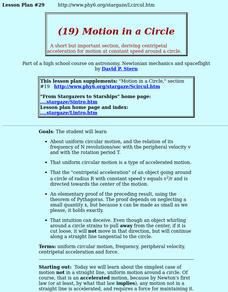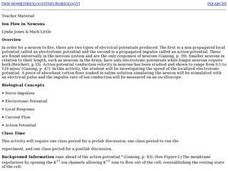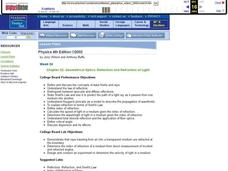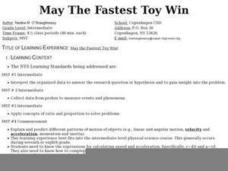Curated OER
Frames of Reference: The Basics
Learners learn the concept of frames of reference in physics. They examine how two frames of reference, each moving with respect to the other with a constant velocity v (constant speed, constant direction).
Curated OER
Motion in a Circle
Students explore uniform circular motion, and the relation of its frequency of N revolutions/sec with the peripheral velocity v and with the rotation period T. They examine how uniform circular motion is a type of accelerated motion.
Curated OER
Investigating Motion
Students determine velocity using the slope of a time distance graph. They investigate a motion cart using a CBR unit and a TI 83 calculator setup. Using the graph generated, they calculate velocity.
Curated OER
Motion in a Circle
Students study about deriving centripetal acceleration for motion at constant speed around a circle.
Curated OER
Einstein's Big Idea
Students create a time line of scientists involved with E = mc2. They describe experiments that led to an understanding of energy, mass, the speed of light squared, and the equivalence of mass and energy. Students relate challenges...
Curated OER
Ion Flow in Neurons
Student perform an experiment in which they determine the velocity of ion flow in an electrotonic potential and compare it to the velocity of action potentials. They record and analyze their results.
Curated OER
Geometrical Optics: Reflection and Refraction of Light
Students define and discus the concepts of wave fronts and rays. In groups, they distinguish between specular and diffuse reflections and use Snell's Law to predict the path of light rays. They calculate the speed of light through...
Curated OER
Physics of Space Flight
In this space flight activity, students will review physics terms relating to space which includes measuring the distance of space objects, how rockets work, and electromagnetic waves. This activity has 10 terms in a crossword puzzle, 6...
Curated OER
Motion and Force
This physics PowerPoint defines the concepts of motion and force. The slideshow consists of an explanation on how motion and force work and give students the chance to demonstrate motion and force through an experiment. The directions...
Alabama Learning Exchange
Energy and Work Amusement Park Style
Students distinguish between kinetic and potential energy. They recognize that energy can change from one form to other forms. They identify and describe several forms of energy.
Curated OER
Characteristic Impedance
In this electrical circuit worksheet, students answer a series of 17 open-ended questions about impedance in electrical cables. Students analyze schematics to answer these questions. This worksheet is printable and the answers are...
Curated OER
Maglev Trains
Students explore how Maglev trains work. In this technology lesson, students discuss the pros and cons of Maglev compared to conventional trains. They build a simple Maglev train model.
Curated OER
Building a Roller Coaster
Students describe the law of conservation of energy. They identify the conversion between potential and kinetic energy. They investigate and describe the application of Newton's Laws of Motion.
Curated OER
Stepper Motor
Students compare a stepper motor from a traditional motor. For this physics lesson, students summarize how it works. They build their own stepper motor and explore its uses.
Curated OER
AC Waveforms
In this AC waveforms worksheet, students answer ten questions about AC voltage, frequencies of waveforms and they interpret diagrams of AC voltage.
Curated OER
I'm Inclined to See
Pupils examine motion of a sphere on an inclined plane. In this inclined plane instructional activity students complete an activity to discover basic relationships.
Curated OER
Reel Projects
Students investigate projectile motion. In this projectile motion lesson, students investigate a website with an interactive lesson. Students view the changes in the projectile they see in the lesson. Students watch short video clips and...
Curated OER
May The Fastest Toy Win
Middle schoolers determine which wind-up toy is the fastest. However, they can NOT race the toys. They must find another way. On the first day of the activity, students work in pairs or small groups to develop and write a plan.
Curated OER
HW Unit 10:2-Harmonic Motion
In this harmonic motion worksheet, students answer 9 questions about pendulums, a slinky and characteristics of harmonic motion. They identify the changes in waves as the amplitude gets bigger and interpret a graph of position vs. time.
Curated OER
Boomerangs Keep Coming Back
Students investigate the flight of paper boomerangs. In this flight lesson, students examine the flight variables of paper boomerangs, which they make, by investigating the concepts of lift and drag. They examine what happens when an...
Curated OER
Magnetic Levitation
Students conduct a series of experiments on magnetic levitation. In this physics lesson, students discover how Maglev trains operate. They explain how magnetism make even simple objects levitate.
Curated OER
Bernoulli's Principle and Winged Flight
Third graders study Bernoulli's Principle and Winged Flight. In this biology lesson plan, 3rd graders to see how the decrease in air pressure which occurs when air is moving allows birds to fly.
Curated OER
Rocket Angles
Eighth graders create rockets that be launched at varying angles to determine which angle is best to launch at for the longest distance.
Alabama Learning Exchange
Cosmic Measurements
Students develop two units of measurement to relate to the astronomical unit and the light year. In this astronomy lesson, students use a Twizzler to develop a measurement unit similar to the astronomical unit. They use a moving object,...
























